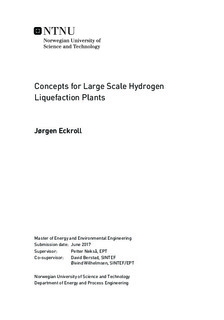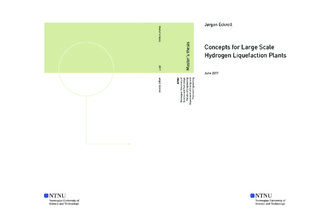| dc.description.abstract | The main objective of this thesis is to perform a technical-exergetic analysis of a large-scale hydrogen liquefaction system. The system boundary of the technical analysis is isolated to the precooling part of the overall process, which gives potential for extensive Case Study Analysis and benchmark possibilities of present conventional systems.
From a hydrogen precooling point of view, the predictions for long- and mid- term development options for a large-scale liquefaction scenario (50-200 tpd), tends towards Mixed Refrigerant and Nitrogen Cycles, both in combination of simple, high-efficiency chillers in the upper temperature region.
Four different Case Study Models has been simulated in Aspen HYSYS, optimized and re-modified with emphasis on the net exergy destruction within the entire process model, the overall exergy efficiency defined by the system boundary and specific energy consumption of the isolated system. The two baseline models has been adapted from the Liquified Natural Gas (LNG) industry, where the utilization rate of Mixed Refrigerants has a high level of experience. The two precooling processes are the Single Mixed Refrigerant (PRICO) process and the Cascade Mixed Refrigerant process.
The precooling systems are simulated both in combination with and without integration of R290-Chillers (propane) and with additional cooling of a generic nelium stream as cryogenic working fluid. Recent concepts of complete liquefac- tion systems, propose to perform heat integration of the cryogenic fluid into the precooling process, in favour of heat transfer minimization. Hence, a process with integrated cryogenic working fluids creates a better framework model, easier to adapt into a bigger system for future work.
Each of the Case Study models were optimized by employment of simulation iterations i, where the best performing simulation from each Case Study Model was benchmarked with a conventional Liquid Nitrogen Precooling process.
With an average hydrogen feed of 150 tonnes/day, the CMR precooling process with implemented chillers and integrated liquid expanders, proves to be the most energy- and exergy efficient process, with an exergy efficiency calculated to above 45,0% and a corresponding specific energy consumption of 1,974 kWh/kgH2, re- quired to cool both the hydrogen feed stream and nelium working fluid down to a temperature of 130 K. Reassignment to higher isentropic efficiencies for ex- panders and compressors were tested for each Case Study model, resulting in an exergy efficiency above 50% for the equivalent CMR+ process. | |

